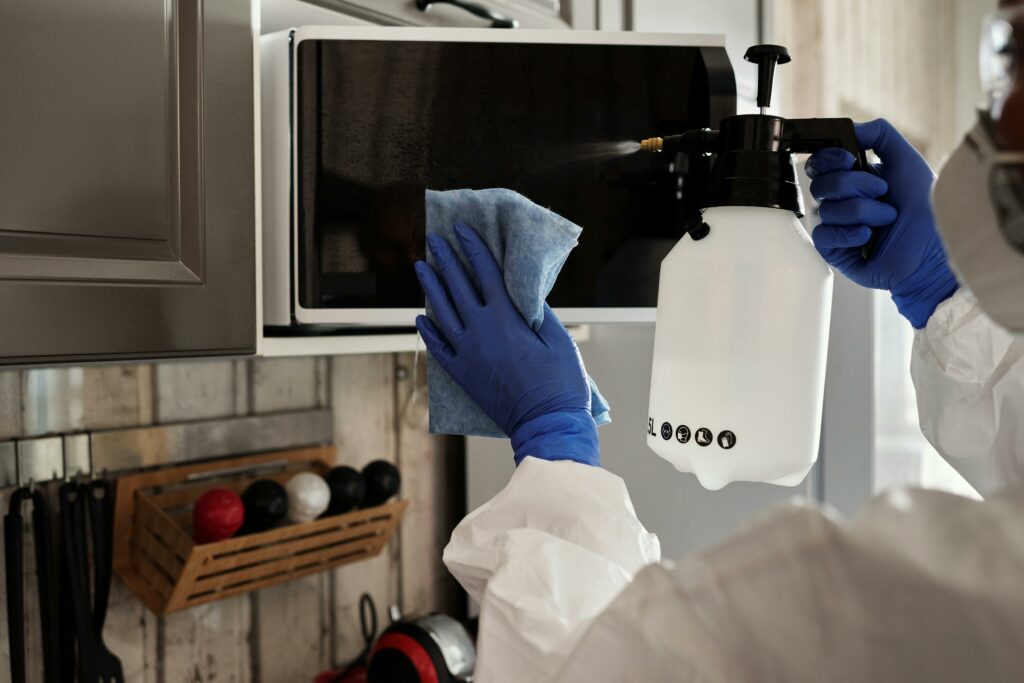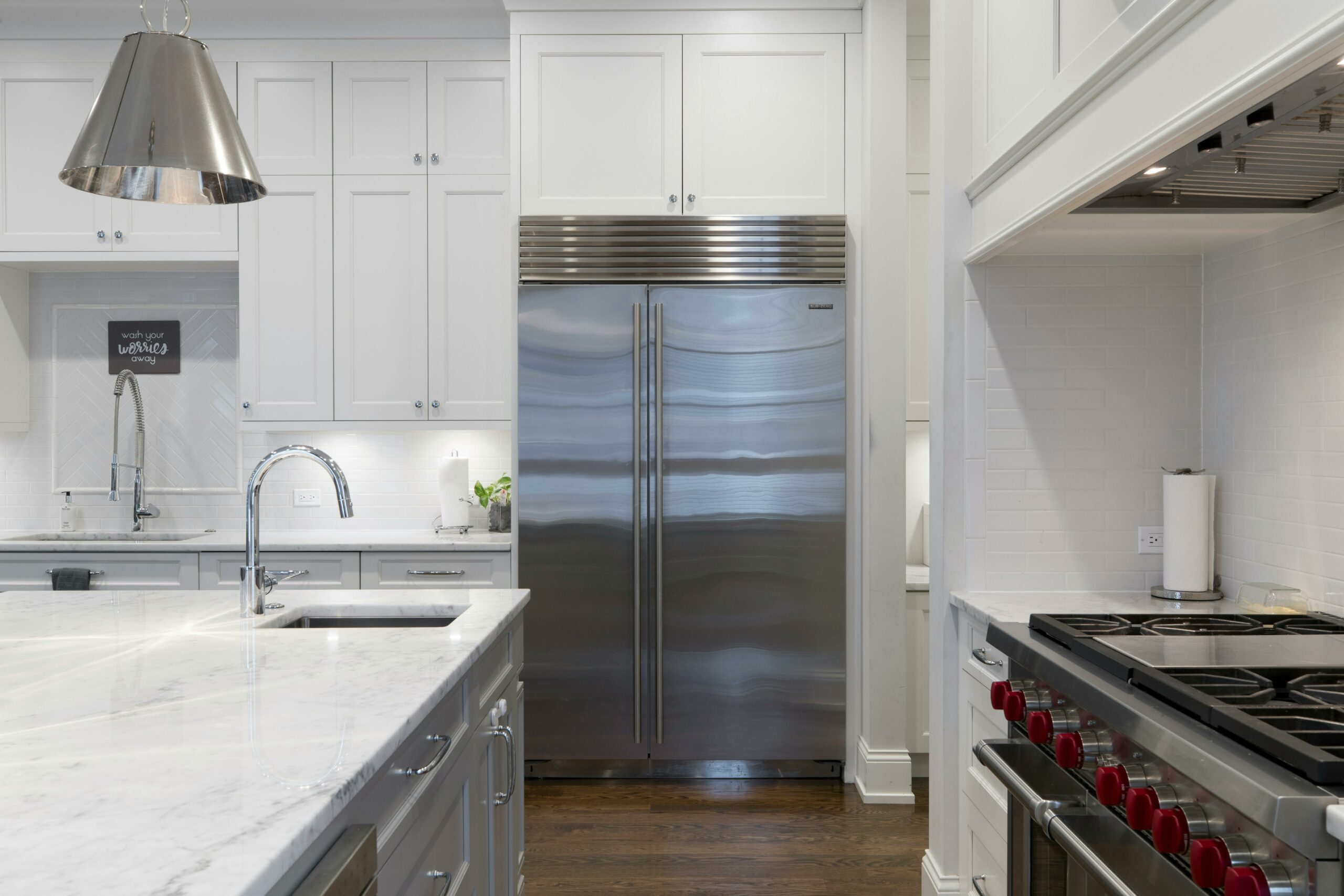A clean kitchen is essential for a healthy and functional home. Over time, grease, food particles, and bacteria accumulate on surfaces, making deep cleaning necessary to maintain hygiene and prevent unpleasant odors. Proper deep cleaning not only ensures a sparkling kitchen but also helps extend the lifespan of appliances, countertops, and cabinets. This guide will walk you through the most effective techniques to perform a thorough deep clean, with a particular focus on removing stubborn grease.
Key Takeaways
- A deep cleaning routine ensures a hygienic and organized kitchen environment.
- Grease buildup can harbor bacteria and cause long-term damage to surfaces.
- Using the right cleaning products and techniques is crucial for effective grease removal.
- Regular deep cleaning prolongs the life of kitchen appliances and prevents odors.
- Natural cleaning solutions can be as effective as chemical-based products.
Why Deep Cleaning Your Kitchen is Essential
A deep clean goes beyond surface-level tidying. Over time, grease and grime accumulate on countertops, cabinets, and appliances, creating an environment where bacteria thrive. Without thorough cleaning, these contaminants can affect the quality of food preparation and contribute to unpleasant kitchen odors. Regular deep cleaning keeps your kitchen looking pristine and ensures a healthier cooking space for you and your family.
Deep cleaning removes hidden dirt, eliminates bacteria, and prevents cross-contamination. A clean kitchen also reduces the chances of attracting pests such as ants and cockroaches. Grease accumulation can lead to long-term damage to appliances, making maintenance and cleaning even more important.
Step-by-Step Deep Cleaning Guide for the Kitchen
A well-structured approach is key to ensuring every inch of your kitchen is thoroughly cleaned and free from grease. Deep cleaning your kitchen involves tackling hidden grime, disinfecting high-touch areas, and using the right techniques to break down stubborn grease. By following a methodical process, you can maintain a hygienic and fresh-smelling space that enhances your cooking experience while extending the life of your kitchen surfaces and appliances.
Step 1: Declutter and Prepare the Kitchen
- Remove all items from countertops, cabinets, and shelves to access all surfaces.
- Dispose of expired food, empty containers, and unnecessary clutter.
- Gather cleaning supplies, including degreasers, microfiber cloths, sponges, and scrub brushes.
Step 2: Clean and Degrease Countertops and Cabinets
- Wipe down all countertops with a mixture of warm water and dish soap.
- Use a degreaser or a vinegar and baking soda solution to break down grease buildup.
- Scrub cabinet doors, handles, and drawers, paying extra attention to areas near the stove.
- Dry all surfaces with a clean cloth to prevent moisture damage.
Step 3: Deep Clean the Stove and Oven
- Remove stove grates and soak them in warm, soapy water for 30 minutes.
- Scrub burners and stovetop with a baking soda paste to remove grease stains.
- Apply a thick layer of baking soda inside the oven and let it sit overnight before wiping clean.
- Use a vinegar spray to dissolve remaining residue and leave surfaces shining.
Step 4: Sanitize Kitchen Appliances
- Wipe down the exterior of appliances such as the refrigerator, microwave, and dishwasher.
- Clean the inside of the microwave using steam from a lemon and water solution.
- Remove refrigerator shelves and drawers for a thorough wash with warm, soapy water.
- Use a stainless steel cleaner to remove fingerprints and grease smudges from appliances.
Step 5: Disinfect the Sink and Drain
- Sprinkle baking soda in the sink and scrub with a sponge to remove stains.
- Pour vinegar and hot water down the drain to break down grease and odors.
- Use a disinfectant spray on the faucet and handles to eliminate bacteria.
Step 6: Scrub the Floors and Walls
- Sweep and mop floors using hot water and a degreasing cleaner.
- Wipe down kitchen walls, especially near the stove, with warm soapy water.
- For stubborn grease stains, use a mixture of baking soda and water and scrub with a brush.
- Clean high-touch areas such as light switches and doorknobs to remove hidden bacteria.
Step 7: Final Touches and Maintenance
- Replace kitchen items and organize shelves and drawers for easy access.
- Take out the trash and replace liners to prevent lingering odors.
- Open windows or turn on ventilation to allow fresh air circulation.
- Establish a regular cleaning schedule to maintain a grease-free kitchen year-round.
A well-structured approach is key to ensuring every inch of your kitchen is thoroughly cleaned and free from grease. Deep cleaning your kitchen involves tackling hidden grime, disinfecting high-touch areas, and using the right techniques to break down stubborn grease. By following a methodical process, you can maintain a hygienic and fresh-smelling space that enhances your cooking experience while extending the life of your kitchen surfaces and appliances.
Deep cleaning your kitchen requires a systematic approach. Tackling each area efficiently ensures every corner is sanitized and grease-free. From countertops to appliances, following these steps will help you achieve a spotless kitchen.

Cleaning Countertops and Cabinets
Countertops and cabinets are prone to grease buildup, especially around the stove and cooking areas. To remove grease effectively, use a degreaser or a natural solution such as vinegar and baking soda. Scrub the surfaces with a microfiber cloth or a non-abrasive sponge to avoid scratching. Wipe down all surfaces thoroughly to remove grease residues and disinfect high-touch areas such as cabinet handles and drawer pulls.
Grease can accumulate on the tops of cabinets, so using warm soapy water or a specialized kitchen cleaner will help break down the buildup. For wooden cabinets, use a mild detergent to prevent damage to the finish. After cleaning, dry the surfaces completely to prevent moisture-related issues like mold growth.
Cleaning the Stove and Oven
Grease and burnt-on food particles tend to build up in and around the stove and oven. For effective cleaning, remove stove grates and soak them in warm, soapy water for at least 30 minutes. Scrub off any stubborn grease using a brush or scouring pad. Use a baking soda and vinegar paste to clean the stovetop and remove stubborn stains.
For the oven, apply a thick layer of baking soda paste on the interior walls and let it sit for several hours or overnight. Wipe away the residue with a damp cloth and use a vinegar spray to dissolve any remaining grease. Cleaning the oven regularly prevents unpleasant smoke and odors during cooking.
Degreasing Kitchen Appliances
Kitchen appliances such as microwaves, refrigerators, and dishwashers also require deep cleaning to remove grease buildup. Use a mixture of warm water and dish soap to wipe down the exterior surfaces. For stainless steel appliances, apply a vinegar and water solution to remove grease and fingerprints.
Inside the microwave, place a bowl of water with lemon slices and heat it for a few minutes. The steam will loosen grease and food stains, making them easier to wipe away. Regular maintenance of appliances helps improve their efficiency and longevity.
Cleaning the Sink and Faucet
The kitchen sink can harbor bacteria, grease, and food particles if not cleaned regularly. To deep clean the sink, sprinkle baking soda over the surface and scrub with a sponge. Pour vinegar down the drain to break down grease and deodorize the pipes. Use a disinfectant spray on the faucet and handles to eliminate germs.
Grease can accumulate in the drain, leading to clogs. Boiling water combined with dish soap or a mixture of baking soda and vinegar can help clear out grease buildup. Keeping the sink and drain clean prevents bad odors and ensures proper drainage.
Scrubbing the Floors and Walls
Kitchen floors and walls often collect grease and grime, especially near the stove and preparation areas. Use a mop with hot water and a degreasing cleaner to remove sticky residues from tiles or hardwood floors. For stubborn grease stains, applying a paste of baking soda and water and scrubbing with a soft brush can help lift the buildup. Steam mops are also an effective, chemical-free option for breaking down grease on hard surfaces. Wipe down kitchen walls with warm soapy water to prevent grease stains from setting in. A mixture of white vinegar and water can also be used for an extra degreasing effect. For painted walls, use a mild detergent to avoid damage while still cutting through the grease.
For stubborn grease spots on walls, a mixture of baking soda and water can help break down the buildup. Let the mixture sit for a few minutes before scrubbing with a non-abrasive sponge. For tiles and grout, a combination of hydrogen peroxide and baking soda can help remove deep-set grease and restore brightness to the surface. Regularly cleaning these areas prevents the spread of bacteria and keeps the kitchen looking fresh. High-touch areas such as light switches, door handles, and backsplash tiles should also be disinfected to eliminate germs and ensure a fully sanitized kitchen environment.
Using Natural Cleaners for Grease Removal
Natural cleaning solutions can be just as effective as chemical degreasers. Vinegar, baking soda, lemon juice, and dish soap are excellent alternatives for breaking down grease and disinfecting surfaces. A mixture of equal parts vinegar and water works well for cleaning cabinets and countertops. Baking soda acts as a gentle abrasive, lifting grease without damaging surfaces.
Lemon juice has antibacterial properties and can cut through grease on stovetops, sinks, and countertops while leaving a fresh, citrus scent. It is particularly effective when used in combination with other natural cleaning agents. Mixing lemon juice with salt creates a powerful scrubbing paste that works wonders on tough grease stains and burnt-on food. This method is especially useful for cleaning pots, pans, and oven interiors. These natural solutions are safer for the environment and help reduce exposure to harsh chemicals in the kitchen. Additionally, using natural ingredients minimizes the risk of allergic reactions and respiratory issues caused by synthetic cleaning products. Regular use of these alternatives not only keeps your kitchen clean but also contributes to a healthier home overall.
Maintaining a Grease-Free Kitchen
Preventing grease buildup in the kitchen requires consistency and the right techniques. Grease from cooking can settle on surfaces, creating a sticky residue that becomes harder to remove over time. To avoid excessive grease accumulation, it’s essential to establish daily, weekly, and monthly cleaning routines. Regular maintenance will not only keep your kitchen looking spotless but also extend the lifespan of your appliances, cabinets, and walls.
To prevent excessive grease buildup, wipe down surfaces regularly after cooking using a damp microfiber cloth or a degreasing spray. This helps to remove fresh grease before it hardens and becomes more difficult to clean. Using range hood filters helps capture airborne grease, reducing its accumulation on cabinets and walls. It’s crucial to clean or replace these filters every few weeks to ensure optimal performance and prevent grease from circulating in the air. Regularly cleaning filters ensures they function efficiently.
Keeping a consistent cleaning schedule, including weekly wipe-downs and monthly deep cleans, helps maintain a hygienic and grease-free kitchen. Consider using hot water mixed with dish soap for daily cleaning and a stronger degreasing agent for deeper cleans. Implementing simple habits such as wiping spills immediately, using splatter guards while cooking, and ensuring proper ventilation reduces the amount of grease that settles on surfaces. Regularly cleaning the backsplash, light fixtures, and even the ceiling near cooking areas can further prevent stubborn grease buildup.
Frequently Asked Questions
1. What is the best way to remove grease from kitchen surfaces?
The most effective way to remove grease from kitchen surfaces is by using a degreaser or a natural cleaning solution like vinegar and baking soda. Applying warm soapy water and scrubbing with a microfiber cloth can also break down grease and grime.
2. How often should I deep clean my kitchen?
Deep cleaning your kitchen should be done at least once a month. However, high-traffic kitchens or those used frequently for cooking greasy foods may require deep cleaning every two weeks.
3. Can I use vinegar and baking soda to clean my entire kitchen?
Yes, vinegar and baking soda are excellent natural cleaners that can be used to clean most kitchen surfaces, including countertops, cabinets, and sinks. However, avoid using vinegar on natural stone surfaces like granite or marble, as it can cause damage.
4. How do I prevent grease buildup in my kitchen?
To prevent grease buildup, clean kitchen surfaces regularly, wipe spills immediately, and use range hood filters to capture grease particles. Cooking with splatter guards and using less oil can also help reduce grease accumulation.
Final Thoughts
Deep cleaning your kitchen is essential for maintaining a hygienic and grease-free environment. Regular cleaning and the use of effective degreasing techniques prevent stubborn buildup and ensure a fresh, functional cooking space. Whether using natural solutions or commercial degreasers, keeping your kitchen clean improves the overall health and longevity of your appliances and surfaces. By following these steps, you can enjoy a spotless and welcoming kitchen year-round.





